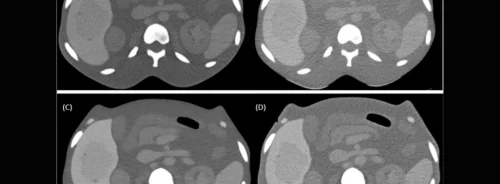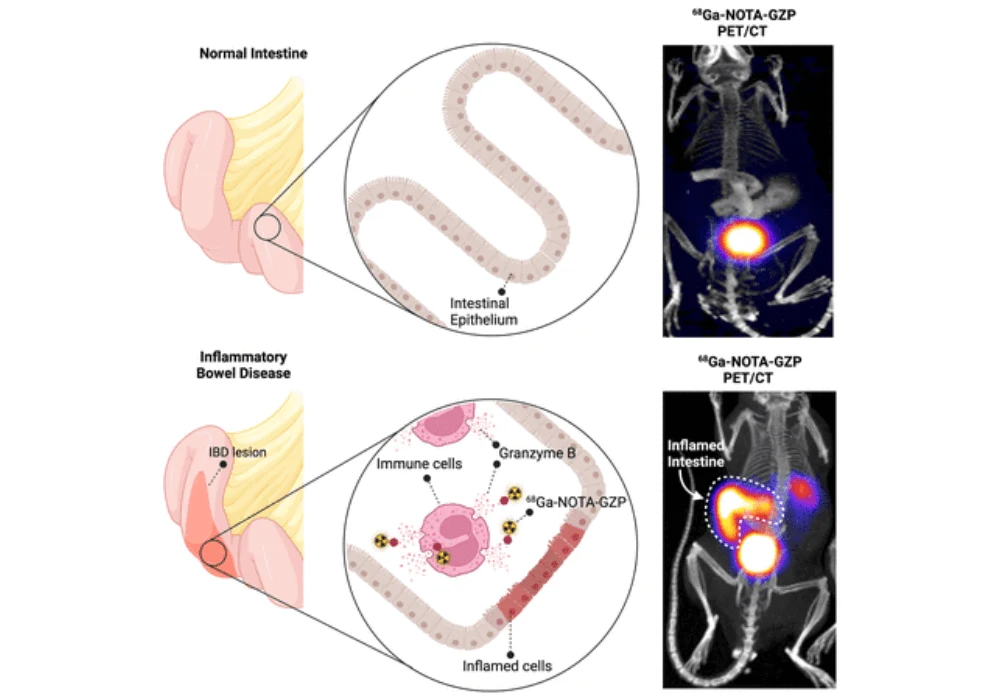Inflammatory bowel disease (IBD) is a chronic condition characterised by persistent inflammation of the gastrointestinal tract, encompassing two primary disorders: Crohn's disease (CD) and ulcerative colitis (UC). Despite significant advancements in the clinical management of IBD, challenges remain, particularly in enhancing diagnostic accuracy, managing treatment intolerance, and addressing the recurrent cycles of remission and relapse. Moreover, long-term IBD increases the risk of colorectal cancer, necessitating continuous monitoring of disease activity. Current diagnostic methods, such as endoscopy, are limited by their invasiveness and inability to detect abnormalities in the deeper layers of the bowel. Emerging imaging technologies, including PET/CT and PET/MRI, provide a more comprehensive view, yet there remains a pressing need for non-invasive techniques that can offer real-time, detailed assessments of inflammatory processes throughout the bowel.
The Role of Immune Cells and GZMB in IBD
The pathophysiology of IBD involves complex interactions between the innate and adaptive immune systems. In particular, natural killer (NK) cells and CD8+ cytotoxic T cells are crucial in the inflammatory cascade, initiating immune responses that lead to tissue damage. Granzyme B (GZMB), a serine protease secreted by these cells, plays a pivotal role in this process by inducing apoptosis in target cells, including those implicated in IBD. This enzyme is not only involved in clearing infected or malignant cells but also in driving inflammation by affecting mucosal immunity. The early release of GZMB in response to immune activation makes it a potential biomarker for detecting and monitoring IBD. Therefore, PET imaging targeting GZMB can provide a non-invasive method to assess the inflammatory status of the mucosal immune layer, offering valuable insights into the early stages of the disease.
GZMB PET Imaging: A New Frontier in IBD Diagnosis
To capitalise on GZMB's potential as a diagnostic marker, researchers developed a specific PET imaging probe, 68Ga-NOTA-GZP, which targets GZMB activity. This probe has shown promise in noninvasively assessing immune responses in preclinical cancer models, suggesting its applicability in IBD. A comprehensive bioinformatics analysis of human IBD tissue samples revealed significant upregulation of the GZMB gene in both CD and UC compared to non-inflamed tissues, underscoring its potential role as a biomarker. Further immunofluorescence studies confirmed these findings, showing robust GZMB expression in actively inflamed bowel tissues, as opposed to quiescent or non-IBD samples. These results suggest that GZMB PET imaging could be a powerful tool for detecting active inflammation, monitoring disease progression, and evaluating treatment responses in IBD patients.
Advantages of GZMB PET Imaging Over Traditional Methods
Traditional diagnostic approaches, such as endoscopy and tissue biopsies, are often invasive and limited in scope, providing only a snapshot of the disease in accessible regions. In contrast, GZMB PET imaging offers a non-invasive, whole-body imaging modality that can detect inflammation throughout the gastrointestinal tract, including areas not reachable by endoscopy. This technique's high temporal resolution allows for continuous monitoring of disease activity, which is crucial for managing the unpredictable nature of IBD. Moreover, GZMB PET imaging specifically targets the enzymatic activity associated with immune responses, providing insights into the underlying immunological mechanisms driving the disease. This capability is particularly valuable in an autoimmune condition like IBD, where the immune system's dysregulation is a primary concern. By focusing on the functional state of immune cells rather than merely their presence, GZMB PET imaging offers a more nuanced understanding of disease activity, potentially leading to more targeted and effective treatments.
GZMB PET imaging significantly advances the non-invasive diagnosis and management of IBD. By providing a comprehensive and real-time view of immune activity, this technology can improve the accuracy of disease monitoring and treatment assessment, leading to better patient outcomes. The specificity of GZMB PET imaging in detecting active inflammation makes it a promising tool for identifying the onset of disease flares and evaluating the efficacy of therapeutic interventions. Future research should focus on validating these findings in clinical settings and exploring the potential of GZMB PET imaging to revolutionise the management of IBD. As we move toward more personalised medicine, this innovative imaging approach could become a cornerstone in the diagnostic and therapeutic landscape of inflammatory bowel disease, offering new hope for patients and healthcare providers alike.
Source & Image Credit: Journal of Nuclear Medicine






